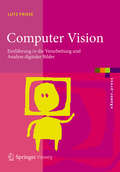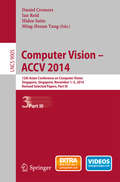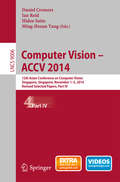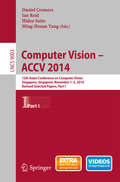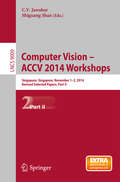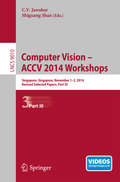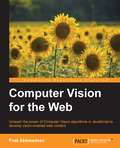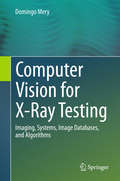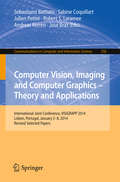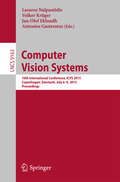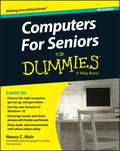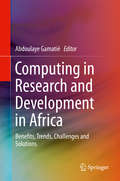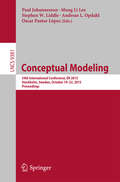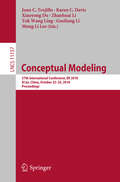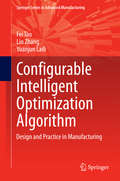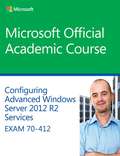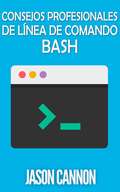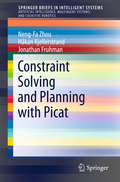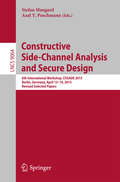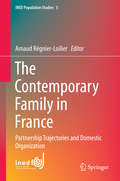- Table View
- List View
Computer Vision: Einführung in die Verarbeitung und Analyse digitaler Bilder (eXamen.press)
by Lutz PrieseDer Autor erläutert in dieser Einführung auf Bachelorniveau die in der Computer Vision verwendeten technischen Ausdrücke: Grundlagen des menschlichen Sehens, Farbe, exakte Begriffsbestimmungen zum Thema "Bild", Transformationen, lineare und nicht-lineare Filter, Fouriertransformation, Morphologie, Merkmale im Bild wie Kanten, Ecken, geometrische Formen mittels Hough-Transformation, diverse Hüllen und Skelettierung. Ferner höhere Merkmale wie SIFT, Shape-Context und statistische Merkmale, Texturmerkmale. Die Bestimmung von Segmenten (zusammenhängende Regionen ähnlicher Farben oder Grauwerte) wird in einem eigenen Kapitel ausführlich behandelt.
Computer Vision -- ACCV 2014: 12th Asian Conference on Computer Vision, Singapore, Singapore, November 1-5, 2014, Revised Selected Papers, Part III (Lecture Notes in Computer Science #9005)
by Daniel Cremers Ian Reid Hideo Saito Ming-Hsuan YangThe five-volume set LNCS 9003--9007 constitutes the thoroughly refereed post-conference proceedings of the 12th Asian Conference on Computer Vision, ACCV 2014, held in Singapore, Singapore, in November 2014. The total of 227 contributions presented in these volumes was carefully reviewed and selected from 814 submissions. The papers are organized in topical sections on recognition; 3D vision; low-level vision and features; segmentation; face and gesture, tracking; stereo, physics, video and events; and poster sessions 1-3.
Computer Vision -- ACCV 2014: 12th Asian Conference on Computer Vision, Singapore, Singapore, November 1-5, 2014, Revised Selected Papers, Part IV (Lecture Notes in Computer Science #9006)
by Daniel Cremers Ian Reid Hideo Saito Ming-Hsuan YangThe five-volume set LNCS 9003--9007 constitutes the thoroughly refereed post-conference proceedings of the 12th Asian Conference on Computer Vision, ACCV 2014, held in Singapore, Singapore, in November 2014. The total of 227 contributions presented in these volumes was carefully reviewed and selected from 814 submissions. The papers are organized in topical sections on recognition; 3D vision; low-level vision and features; segmentation; face and gesture, tracking; stereo, physics, video and events; and poster sessions 1-3.
Computer Vision -- ACCV 2014: 12th Asian Conference on Computer Vision, Singapore, Singapore, November 1-5, 2014, Revised Selected Papers, Part I (Lecture Notes in Computer Science #9003)
by Daniel Cremers Ian Reid Hideo Saito Ming-Hsuan YangThe five-volume set LNCS 9003--9007 constitutes the thoroughly refereed post-conference proceedings of the 12th Asian Conference on Computer Vision, ACCV 2014, held in Singapore, Singapore, in November 2014. The total of 227 contributions presented in these volumes was carefully reviewed and selected from 814 submissions. The papers are organized in topical sections on recognition; 3D vision; low-level vision and features; segmentation; face and gesture, tracking; stereo, physics, video and events; and poster sessions 1-3.
Computer Vision - ACCV 2014 Workshops: Singapore, Singapore, November 1-2, 2014, Revised Selected Papers, Part II (Lecture Notes in Computer Science #9009)
by C. V. Jawahar Shiguang ShanThe three-volume set, consisting of LNCS 9008, 9009, and 9010, contains carefully reviewed and selected papers presented at 15 workshops held in conjunction with the 12th Asian Conference on Computer Vision, ACCV 2014, in Singapore, in November 2014. The 153 full papers presented were selected from numerous submissions. LNCS 9008 contains the papers selected for the Workshop on Human Gait and Action Analysis in the Wild, the Second International Workshop on Big Data in 3D Computer Vision, the Workshop on Deep Learning on Visual Data, the Workshop on Scene Understanding for Autonomous Systems, and the Workshop on Robust Local Descriptors for Computer Vision. LNCS 9009 contains the papers selected for the Workshop on Emerging Topics on Image Restoration and Enhancement, the First International Workshop on Robust Reading, the Second Workshop on User-Centred Computer Vision, the International Workshop on Video Segmentation in Computer Vision, the Workshop: My Car Has Eyes: Intelligent Vehicle with Vision Technology, the Third Workshop on E-Heritage, and the Workshop on Computer Vision for Affective Computing. LNCS 9010 contains the papers selected for the Workshop on Feature and Similarity for Computer Vision, the Third International Workshop on Intelligent Mobile and Egocentric Vision, and the Workshop on Human Identification for Surveillance.
Computer Vision - ACCV 2014 Workshops, Part III: Singapore, Singapore, November 1-2, 2014, Revised Selected Papers, Part III (Lecture Notes in Computer Science #9010)
by C. V. Jawahar Shiguang ShanThe three-volume set, consisting of LNCS 9008, 9009, and 9010, contains carefully reviewed and selected papers presented at 15 workshops held in conjunction with the 12th Asian Conference on Computer Vision, ACCV 2014, in Singapore, in November 2014. The 153 full papers presented were selected from numerous submissions. LNCS 9008 contains the papers selected for the Workshop on Human Gait and Action Analysis in the Wild, the Second International Workshop on Big Data in 3D Computer Vision, the Workshop on Deep Learning on Visual Data, the Workshop on Scene Understanding for Autonomous Systems and the Workshop on Robust Local Descriptors for Computer Vision. LNCS 9009 contains the papers selected for the Workshop on Emerging Topics on Image Restoration and Enhancement, the First International Workshop on Robust Reading, the Second Workshop on User-Centred Computer Vision, the International Workshop on Video Segmentation in Computer Vision, the Workshop: My Car Has Eyes: Intelligent Vehicle with Vision Technology, the Third Workshop on E-Heritage and the Workshop on Computer Vision for Affective Computing. LNCS 9010 contains the papers selected for the Workshop on Feature and Similarity for Computer Vision, the Third International Workshop on Intelligent Mobile and Egocentric Vision and the Workshop on Human Identification for Surveillance.
Computer Vision for the Web
by Foat AkhmadeevUnleash the power of the Computer Vision algorithms in JavaScript to develop vision-enabled web content About This Book * Explore the exciting world of image processing, and face and gesture recognition, and implement them in your website * Develop wonderful web projects to implement Computer Vision algorithms in an effective way * A fast-paced guide to help you deal with real-world Computer Vision applications using JavaScript libraries Who This Book Is For If you have an interest in Computer Vision or wish to apply Computer Vision algorithms such as face, custom object, and gesture recognition for an online application, then this book is ideal for you. Prior understanding of the JavaScript language and core mathematical concepts is recommended. What You Will Learn * Apply complex Computer Vision algorithms in your applications using JavaScript * Put together different JavaScript libraries to discover objects in photos * Get to grips with developing simple computer vision applications on your own * Understand when and why you should use different computer vision methods * Apply various image filters to images and videos * Recognize and track many different objects, including face and face particles using powerful face recognition algorithms * Explore ways to control your browser without touching the mouse or keyboard In Detail JavaScript is a dynamic and prototype-based programming language supported by every browser today. JavaScript libraries boast outstanding functionalities that enable you to furnish your own Computer Vision projects, making it easier to develop JavaScript-based applications, especially for web-centric technologies. It makes the implementation of Computer Vision algorithms easier as it supports scheme-based functional programming. This book will give you an insight into controlling your applications with gestures and head motion and readying them for the web. Packed with real-world tasks, it begins with a walkthrough of the basic concepts of Computer Vision that the JavaScript world offers us, and you'll implement various powerful algorithms in your own online application. Then, we move on to a comprehensive analysis of JavaScript functions and their applications. Furthermore, the book will show you how to implement filters and image segmentation, and use tracking.js and jsfeat libraries to convert your browser into Photoshop. Subjects such as object and custom detection, feature extraction, and object matching are covered to help you find an object in a photo. You will see how a complex object such as a face can be recognized by a browser as you move toward the end of the book. Finally, you will focus on algorithms to create a human interface. By the end of this book, you will be familiarized with the application of complex Computer Vision algorithms to develop your own applications, without spending much time learning sophisticated theory. Style and approach This book is an easy-to-follow project-based guide that throws you directly into the excitement of the Computer Vision theme. A "more in less" approach is followed by important concepts explained in a to-the-point, easy-to-understand manner.
Computer Vision for X-Ray Testing: Imaging, Systems, Image Databases, and Algorithms
by Domingo MeryThis accessible textbook presents an introduction to computer vision algorithms for industrially-relevant applications of X-ray testing. Features: introduces the mathematical background for monocular and multiple view geometry; describes the main techniques for image processing used in X-ray testing; presents a range of different representations for X-ray images, explaining how these enable new features to be extracted from the original ℑ examines a range of known X-ray image classifiers and classification strategies; discusses some basic concepts for the simulation of X-ray images and presents simple geometric and imaging models that can be used in the simulation; reviews a variety of applications for X-ray testing, from industrial inspection and baggage screening to the quality control of natural products; provides supporting material at an associated website, including a database of X-ray images and a Matlab toolbox for use with the book's many examples.
Computer Vision, Imaging and Computer Graphics - Theory and Applications: International Joint Conference, Visigrapp 2014, Lisbon Portugal, January 5-8, 2014, Revised Selected Papers (Communications In Computer And Information Science #550)
by Sabine Coquillart Sebastiano Battiato Julien Pettré Robert S. Laramee Andreas Kerren José BrazThis book constitutes the refereed proceedings of the International Conference, VISIGRAPP 2014, consisting of the Joint Conferences on Computer Vision (VISAPP), the International Conference on Computer Graphics, GRAPP 2014 and the International Conference on Information Visualization, IVAPP 2014, held in Lisbon, Portugal, in January 2014. The 22 revised full papers presented were carefully reviewed and selected from 543 submissions. The papers are organized in topical sections on computer graphics theory and applications; information visualization - theory and applications; computer vision theory and applications.
Computer Vision in Control Systems-1: Innovations in Practice (Intelligent Systems Reference Library #75)
by Lakhmi C. Jain Margarita N. FavorskayaThis book is focused on the recent advances in computer vision methodologies and technical solutions using conventional and intelligent paradigms. The Contributions include: · Morphological Image Analysis for Computer Vision Applications. · Methods for Detecting of Structural Changes in Computer Vision Systems. · Hierarchical Adaptive KL-based Transform: Algorithms and Applications. · Automatic Estimation for Parameters of Image Projective Transforms Based on Object-invariant Cores. · A Way of Energy Analysis for Image and Video Sequence Processing. · Optimal Measurement of Visual Motion Across Spatial and Temporal Scales. · Scene Analysis Using Morphological Mathematics and Fuzzy Logic. · Digital Video Stabilization in Static and Dynamic Scenes. · Implementation of Hadamard Matrices for Image Processing. · A Generalized Criterion of Efficiency for Telecommunication Systems. The book is directed to PhD students, professors, researchers and software developers working in the areas of digital video processing and computer vision technologies.
Computer Vision Systems: 10th International Conference, ICVS 2015, Copenhagen, Denmark, July 6-9, 2015, Proceedings (Lecture Notes in Computer Science #9163)
by Volker Krüger Lazaros Nalpantidis Jan-Olof Eklundh Antonios GasteratosThis book constitutes the refereed proceedings of the 10th International Conference on Computer Vision Systems, ICVS 2015, held in Copenhagen, Denmark, in July 2015. The 48 papers presented were carefully reviewed and selected from 92 submissions. The paper are organized in topical sections on biological and cognitive vision; hardware-implemented and real-time vision systems; high-level vision; learning and adaptation; robot vision; and vision systems applications.
Computers For Seniors For Dummies
by Nancy C. Muirng to use a computer for bookkeeping, making travel pans, socializing, shopping, or just plain fun, this clear and friendly guide takes the intimidation out of computer basics and the ever-evolving technology that surrounds it.Large-print format and drawings make it easy to read and understandIncludes chapter openers that present the tasks covered with associated page numbers to help you find material fastContains the most up-to-date information on the Windows 9 operating systemProvides coverage of Windows 8.1 for those who aren't early adoptersIf you've just purchased your first computer or laptop need a plain-English introduction to getting started, Computers For Seniors For Dummies has you covered.
Computing as Writing
by Daniel PundayThis book examines the common metaphor that equates computing and writing, tracing it from the naming of devices ("notebook" computers) through the design of user interfaces (the "desktop") to how we describe the work of programmers ("writing" code). Computing as Writing ponders both the implications and contradictions of the metaphor.During the past decade, analysis of digital media honed its focus on particular hardware and software platforms. Daniel Punday argues that scholars should, instead, embrace both the power and the fuzziness of the writing metaphor as it relates to computing--which isn't simply a set of techniques or a collection of technologies but also an idea that resonates throughout contemporary culture. He addresses a wide array of subjects, including film representations of computing (Desk Set, The Social Network), Neal Stephenson's famous open source manifesto, J. K. Rowling's legal battle with a fan site, the sorting of digital libraries, subscription services like Netflix, and the Apple versus Google debate over openness in computing.Punday shows how contemporary authors are caught between traditional notions of writerly authority and computing's emphasis on doing things with writing. What does it mean to be a writer today? Is writing code for an app equivalent to writing a novel? Should we change how we teach writing? Punday's answers to these questions and others are original and refreshing, and push the study of digital media in productive new directions.
Computing Essentials for an IT Age with Applications
by David FilerComputing Essentials for an IT Age introduces students to the plethora of computer systems and networks - along with the constantly evolving benefits they offer. Created for both online and in-person introduction to computers courses, this turn-key course package includes a beautiful color lecture manual (eBook), lab content, tests, and quizzes all in a digital package.
Computing in Research and Development in Africa: Benefits, Trends, Challenges and Solutions
by Abdoulaye GamatiéThis book describes the trends, challenges and solutions in computing use for scientific research and development within different domains in Africa, such as health, agriculture, environment, economy, energy, education and engineering. The benefits expected are discussed by a number of recognized, domain-specific experts, with a common theme being computing as solution enabler. This book is the first document providing such a representative up-to-date view on this topic at the continent level.
The Computing Universe
by Tony Hey Gyuri PápayComputers now impact almost every aspect of our lives, from our social interactions to the safety and performance of our cars. How did this happen in such a short time? And this is just the beginning. . . . In this book, Tony Hey and Gyuri Pápay lead us on a journey from the early days of computers in the 1930s to the cutting-edge research of the present day that will shape computing in the coming decades. Along the way, they explain the ideas behind hardware, software, algorithms, Moore's Law, the birth of the personal computer, the Internet and the Web, the Turing Test, Jeopardy's Watson, World of Warcraft, spyware, Google, Facebook, and quantum computing. This book also introduces the fascinating cast of dreamers and inventors who brought these great technological developments into every corner of the modern world. This exciting and accessible introduction will open up the universe of computing to anyone who has ever wondered where his or her smartphone came from.
Conceptual Modeling: 34th International Conference, ER 2015, Stockholm, Sweden, October 19-22, 2015, Proceedings (Lecture Notes in Computer Science #9381)
by Paul Johannesson Mong Li Lee Stephen W. Liddle Andreas L. Opdahl Óscar Pastor LópezThis book constitutes the refereed proceedings of the 34th International Conference on Conceptual Modeling, ER 2015, held in Stockholm, Sweden, in October 2015. The 26 full and 19 short papers presented were carefully reviewed and selected from 131 submissions. The papers are organized in topical sections on business process and goal models, ontology-based models and ontology patterns, constraints, normalization, interoperability and integration, collaborative modeling, variability and uncertainty modeling, modeling and visualization of user generated content, schema discovery and evolution, process and text mining, domain-based modeling, data models and semantics, and applications of conceptual modeling.
Conceptual Modeling: 37th International Conference, Er 2018, Xi'an, China, October 22-25, 2018, Proceedings (Lecture Notes in Computer Science #11157)
by Mong Li Lee Guoliang Li Tok Wang Ling Zhanhuai Li Xiaoyong Du Karen C. Davis Juan C. TrujilloThis book constitutes the refereed proceedings of the 37th International Conference on Conceptual Modeling, ER 2018, held in XI'an, China, in October 2018.The 30 full and 13 short papers presented together with 3 keynotes were carefully reviewed and selected from 151 submissions.This events covers a wide range of following topics: Conceptual modeling studies, ontological modeling, semi-structured data modeling, process modeling and management, spatio-temporal modeling, cloud-based modeling, schema and view modeling,languages and models, NoSQL modeling, conceptual modeling for machine learning and reasoning, applications of conceptual modeling.
Configurable Intelligent Optimization Algorithm: Design and Practice in Manufacturing (Springer Series in Advanced Manufacturing)
by Lin Zhang Fei Tao Yuanjun LailiPresenting the concept and design and implementation of configurable intelligent optimization algorithms in manufacturing systems, this book provides a new configuration method to optimize manufacturing processes. It provides a comprehensive elaboration of basic intelligent optimization algorithms, and demonstrates how their improvement, hybridization and parallelization can be applied to manufacturing. Furthermore, various applications of these intelligent optimization algorithms are exemplified in detail, chapter by chapter. The intelligent optimization algorithm is not just a single algorithm; instead it is a general advanced optimization mechanism which is highly scalable with robustness and randomness. Therefore, this book demonstrates the flexibility of these algorithms, as well as their robustness and reusability in order to solve mass complicated problems in manufacturing. Since the genetic algorithm was presented decades ago, a large number of intelligent optimization algorithms and their improvements have been developed. However, little work has been done to extend their applications and verify their competence in solving complicated problems in manufacturing. This book will provide an invaluable resource to students, researchers, consultants and industry professionals interested in engineering optimization. It will also be particularly useful to three groups of readers: algorithm beginners, optimization engineers and senior algorithm designers. It offers a detailed description of intelligent optimization algorithms to algorithm beginners; recommends new configurable design methods for optimization engineers, and provides future trends and challenges of the new configuration mechanism to senior algorithm designers.
Configuring Advanced Windows Server® 2012 R2: Services Exam 70-412 (Microsoft Official Academic Course)
by Microsoft Official Academic Course StaffThis 70-412 Configuring Advanced Windows Server 2012 R2 Services textbook covers the third of three exams required for Microsoft Certified Solutions Associate (MCSA): Windows Server 2012 certification. This course will help validate the skills and knowledge necessary to administer a Windows Server 2012 Infrastructure in an enterprise environment. The three MCSA exams collectively validate the skills and knowledge necessary for implementing, managing, maintaining and provisioning services and infrastructure in a Windows Server 2012 environment. This Microsoft Official Academic Course is mapped to the 70-412 Configuring Advanced Windows Server 2012 Services exam skills, including the recent R2 objectives. This textbook focuses on real skills for real jobs and prepares students to prove mastery of Advanced Windows Server 2012 Services such as advanced configuring tasks necessary to deploy, manage, and maintain a Windows Server 2012 infrastructure.
Confronting the Internet’s Dark Side
by Raphael Cohen-AlmagorTerrorism, cyberbullying, child pornography, hate speech, cybercrime: along with unprecedented advancements in productivity and engagement, the Internet has ushered in a space for violent, hateful, and antisocial behavior. How do we, as individuals and as a society, protect against dangerous expressions online? Confronting the Internet's Dark Side is the first book on social responsibility on the Internet. It aims to strike a balance between the free speech principle and the responsibilities of the individual, corporation, state, and the international community. This book brings a global perspective to the analysis of some of the most troubling uses of the Internet. It urges net users, ISPs, and liberal democracies to weigh freedom and security, finding the golden mean between unlimited license and moral responsibility. This judgment is necessary to uphold the very liberal democratic values that gave rise to the Internet and that are threatened by an unbridled use of technology.
Consejos Profesionales de Línea de Comando Bash
by Jason Cannon Andrés ParraudSi alguna vez te has dicho: "Tiene que haber una mejor forma de hacer esto", sigue leyendo. Como alguien que ha utilizado el Shell Bash casi a diario durante más de 15 años, he acumulado varios "trucos" de línea de comandos que me han ahorrado tiempo y frustraciones. Consejos Profesionales de Línea de Comando Bash es una colección de 10 técnicas que puedes comenzar a utilizar inmediatamente para mejorar tu eficiencia en la línea de comando. Esto es lo que aprenderás leyendo Consejos Profesionales de Línea de Comando Bash: Consejo 1: Autocompletar Consejo 2: Cambiar al Directorio Anterior Consejo 3: Reutilizar el Último Ítem de la Línea Anterior Consejo 4: Volver a Ejecutar un Comando que comienza con una Cadena dada Consejo 5: Sustitución de Comando Consejo 6: Usar un Bucle for en la Línea de Comando Consejo 7: Volver a Ejecutar el Comando Anterior con Privilegios de Root Consejo 8: Volver a Ejecutar el Comando Anterior Sustituyendo una Cadena Consejo 9: Reutilizar una Palabra en la Misma Línea de Comando Consejo 10: Corregir Errores y Acortar Comandos Largos con Alias
Constraint Solving and Planning with Picat (SpringerBriefs in Intelligent Systems #0)
by Neng-Fa Zhou Håkan Kjellerstrand Jonathan FruhmanThis book introduces a new logic-based multi-paradigm programming language that integrates logic programming, functional programming, dynamic programming with tabling, and scripting, for use in solving combinatorial search problems, including CP, SAT, and MIP (mixed integer programming) based solver modules, and a module for planning that is implemented using tabling. The book is useful for undergraduate and graduate students, researchers, and practitioners.
Constructive Side-Channel Analysis and Secure Design: 6th International Workshop, COSADE 2015, Berlin, Germany, April 13-14, 2015. Revised Selected Papers (Lecture Notes in Computer Science #9064)
by Stefan Mangard Axel Y. PoschmannThis book constitutes the thoroughly refereed post-conference proceedings of the 6th International Workshop, COSADE 2015, held in Berlin, Germany, in April 2015. The 17 revised full papers presented were carefully selected from 48 submissions. the focus of this workshop was on following topics: side-channel attacks, FPGA countermeasures, timing attacks and countermeasures, fault attacks, countermeasures, and Hands-on Side-channel analysis.
The Contemporary Family in France
by Arnaud Régnier-LoilierThis book provides a portrait of the family in France today, revealing many of the deep-seated, demographic changes that have affected French society in recent decades. It first focuses on conjugal and family trajectories, examining union formation, types of union, entry into parenthood, influence of religion, and separation. Next, the book explores domestic organization within the couple. It looks at gender differences in attitudes to task-sharing, division of household and parenting tasks, influence of past partnership history, and changes after a birth. The book presents a series of studies based on the French version of the international Generations and Gender Survey, a major comparative research project conducted in 20 countries to collect information from individuals aged 18-79 about relationships and processes in the life course. Inside, readers will find insightful analysis of the survey results by sociologists, demographers, and economists, and come to better understand recent demographic and social developments in France as well as the factors influencing them. The book will appeal to a broad audience of students and researchers interested in family, gender, and intergenerational relations. In addition, as the survey data are comparable across countries, the book will provide researchers with ideas for further research opportunities in Europe and beyond.
